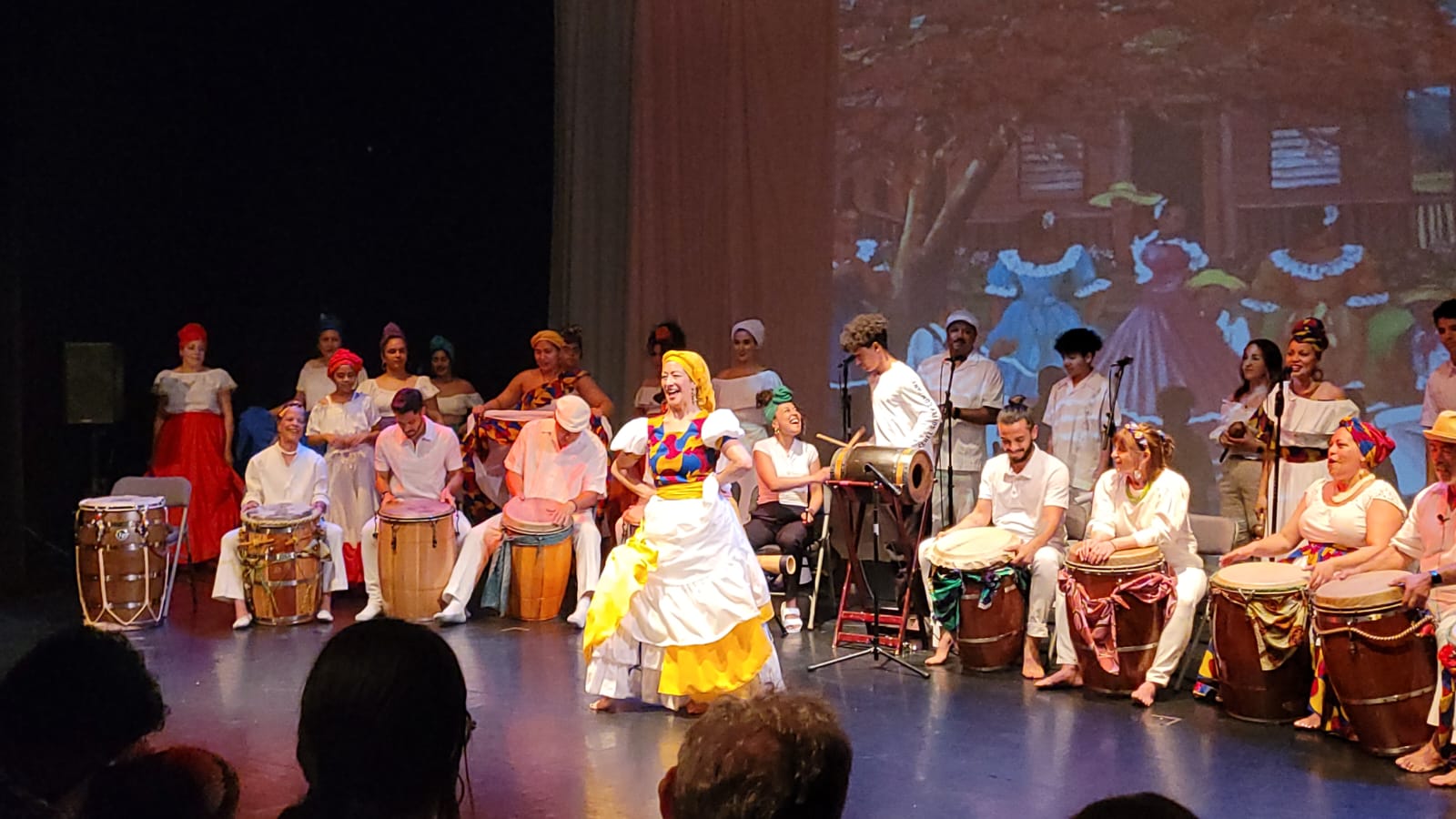By Bethany Greenho
Bethany Greenho is a 2023 Archiving and Preservation Fellow with Cleo Parker Robinson Dance. Read more about the Fellowships here. This is the first part of Bethany’s blog. Read the second part here.
An Explorer in the Archives
Cleo Parker Robinson Dance (CPRD) enters its 53rd season this year. Currently, 52 years’ worth of analog and digital materials documenting CPRD’s history and its founder, Cleo Parker Robinson, are living in multiple locations in the company’s historic home, the Shorter AME Church in the Five Points neighborhood of Denver. To begin overcoming the initial overwhelming feeling brought on by the sheer volume and dispersion of materials, I decided I needed to focus my work this summer on two main questions: 1) What materials does the Cleo Parker Robinson Dance archives hold? 2) How can Cleo and other staff members find and access these materials now and in the future?
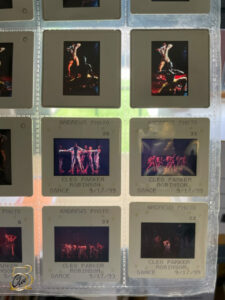
Sleeve of photographic slides showing Cleo Parker Robinson Dance performances. From the Cleo Parker Robinson Dance Archive.
To begin tackling those questions, the first few weeks of my Fellowship have been spent taking a high-level look through the Shorter AME Church to find collection materials and determine what could be included in the CPRD collection. I have crawled under the stage, climbed into the attic, and sat on closet floors going through record boxes and plastic tubs to record the types and formats of materials I have come across along with any names, terms, or years found on their labels. This exploration has enabled me to create categories for the CPRD archive, breaking down what initially overwhelmed me into distinct groups based on the content and use of the materials. This categorization allowed me to see, for example, that the collection was predominantly composed of creative materials, such as choreographic notes and performance footage, and production materials, including tour schedules and production binders. Additionally, from this categorization, it became easier to make decisions about which fields and controlled vocabularies, or standardized terms used to describe similar material, to include in a collection inventory in order to identify, describe, and locate collection materials. Having these categories helped me include fields and terms that are not only pertinent to both the types and formats included in the collection but also to the content of the materials and the kinds of language and information Cleo and staff members use to define and understand materials. Additionally, this general categorization has been the starting point for conversations with Cleo and the staff about their priorities. Knowing the importance of performance-related materials, especially video recordings, to Cleo and other staff members’ daily work has influenced the work I’ve prioritized for completing this summer: inventorying AV and other creative materials I found in my initial exploration as well as developing recommendations for next steps for the archive.
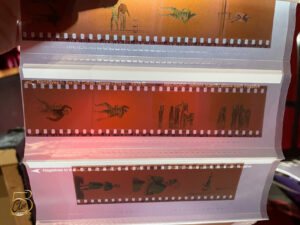
Three sleeves of 35mm photo negatives which include images from Katherine Dunham’s Barrelhouse Blues. From the Cleo Parker Robinson Dance Archive.
Even better, this exploration has also allowed me to be my favorite thing: a researcher and learner. As someone who did not know much about Cleo or CPRD coming into this Fellowship, finding choreographic notes that show Cleo’s choreographic process, photographic negatives of performance photos, and files of outreach programming information packets and schedules has already taught me a great deal about the work that Cleo, her organization, and the staff have been doing for over half a century. More importantly, I am learning all of this from their perspectives and their words. Listening to Cleo and other staff members tell stories about the organization, its activities, and its place in the community has only enhanced the stories I’ve found in the materials. For example, seeing the staging notes and promotional materials for the CPRD Ensemble’s production of Katherine Dunham’s Southland during my initial look through was intriguing purely from the perspective of how much work went into putting this piece on stage. However, listening to Cleo discuss her relationship with Katherine Dunham, her childhood and family background, and the centrality of the African Diaspora and healing to CPRD’s philosophy showed me the deeper significance of this production to Cleo, the organization, and dance history. I can’t wait to explore these materials more carefully when I begin inventorying the paper collection materials and to share more about them in a future post.
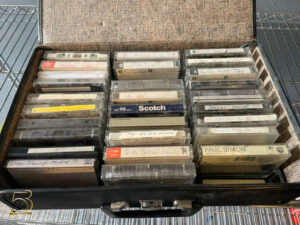
A suitcase with three rows of audio cassette tapes labeled with titles of Cleo Parker Robinson Dance repertoire pieces. From the Cleo Parker Robinson Dance Archive.
The question now becomes: how can the archive and the work I am doing this summer better enable future students, dancers, and researchers to learn these stories and their significance if they do not have the privilege of hearing directly from the company’s founder or the staff? Although I am still in the midst of digging into this question, my time spent talking with the staff about the stories they want their archive to tell, looking at how other Black dance artists’ archival collections have been described, and keeping the organization’s ethos of One Spirit/Many Voices, of dance as a universal language that transcends boundaries and enables individual expression, in mind has helped me begin to tweak the inventory and determine where my work should follow traditional archival practice and where it might be best to forge a new path.
Ultimately, this time spent exploring the materials and speaking with staff has been a constant reminder of the importance of archives. Archives not only preserve history, they hold stories that offer new understandings and appreciations of individuals, communities, and histories. I am excited to continue the work with Cleo and her staff to help begin making the 52 years of materials and their stories findable, accessible, and widely appreciated.
Header image: photo by Jerry Metellus, courtesy of Cleo Parker Robinson Dance Ensemble.
All other images courtesy of the author.
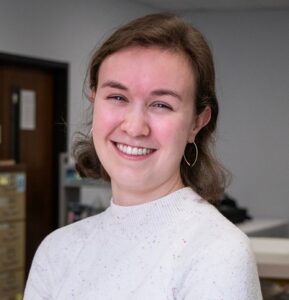 Bethany Greenho (she/her) is finishing a master’s degree in library and information science with a focus in archives and digital curation at the University of Maryland, College Park. She is interested in discovering how user-oriented access and ethical and community-centered description can become the means through which hidden or ignored stories become findable and accessible.
Bethany Greenho (she/her) is finishing a master’s degree in library and information science with a focus in archives and digital curation at the University of Maryland, College Park. She is interested in discovering how user-oriented access and ethical and community-centered description can become the means through which hidden or ignored stories become findable and accessible.
Bethany’s work with the George Balanchine Trust showed her the importance of having access to the tangible artifacts of dance as a way to preserve dance and its history beyond its ephemeral nature. In her current work with the University of Maryland Libraries Preservation Department, Bethany has seen how preservation works in concert with archives to ensure continued access to all stories.
Bethany is excited to use her background in dance and archival science at the Cleo Parker Robinson Dance Company to begin the process of organizing and preserving their collections to make them accessible to the community. Photo courtesy of Bethany Greenho.
____
We accept submissions on topics relevant to the field: advocacy, artistic issues, arts policy, community building, development, employment, engagement, touring, and other topics that deal with the business of dance. We cannot publish criticism, single-company season announcements, and single-company or single artist profiles. Additionally, we welcome feedback on articles. If you have a topic that you would like to see addressed or feedback, please contact communications@danceusa.org.
Disclaimer: Opinions expressed in guest posts do not necessarily represent the viewpoints of Dance/USA.




